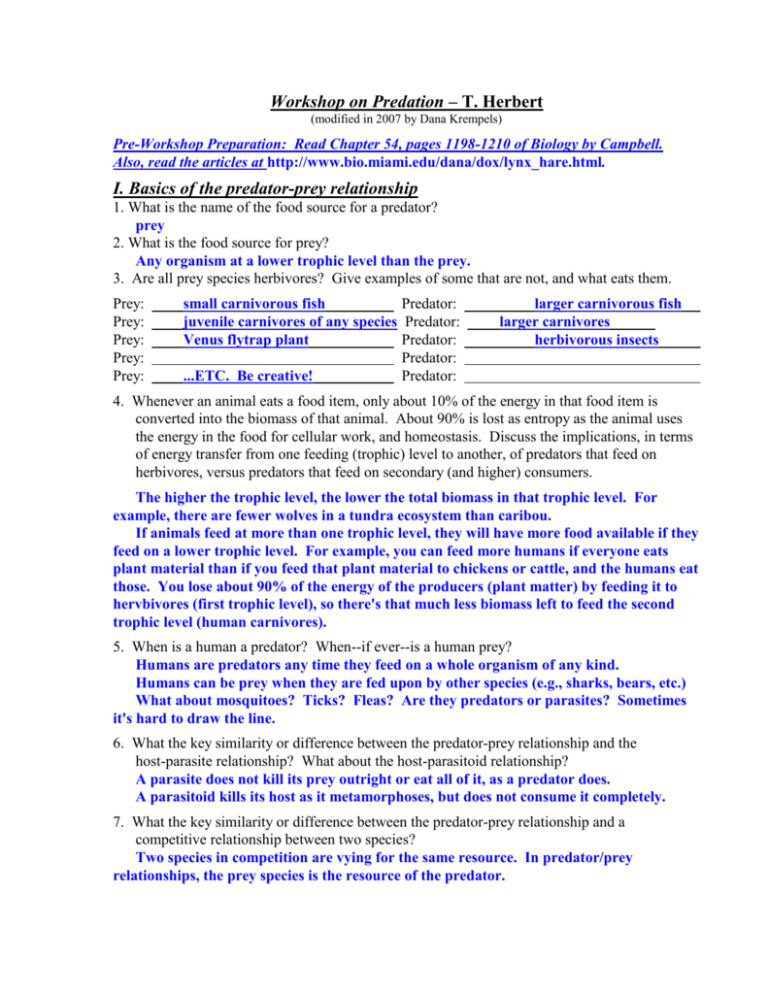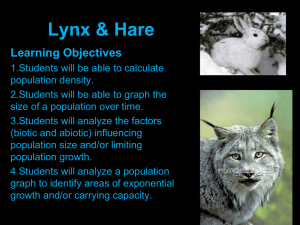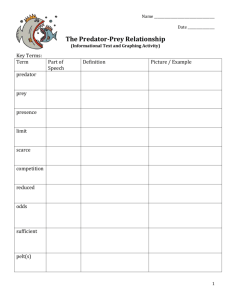Workshop on Predation
advertisement

Workshop on Predation – T. Herbert (modified in 2007 by Dana Krempels) Pre-Workshop Preparation: Read Chapter 54, pages 1198-1210 of Biology by Campbell. Also, read the articles at http://www.bio.miami.edu/dana/dox/lynx_hare.html. I. Basics of the predator-prey relationship 1. What is the name of the food source for a predator? prey 2. What is the food source for prey? Any organism at a lower trophic level than the prey. 3. Are all prey species herbivores? Give examples of some that are not, and what eats them. Prey: Prey: Prey: Prey: Prey: small carnivorous fish Predator: juvenile carnivores of any species Predator: Venus flytrap plant Predator: Predator: ...ETC. Be creative! Predator: larger carnivorous fish larger carnivores herbivorous insects 4. Whenever an animal eats a food item, only about 10% of the energy in that food item is converted into the biomass of that animal. About 90% is lost as entropy as the animal uses the energy in the food for cellular work, and homeostasis. Discuss the implications, in terms of energy transfer from one feeding (trophic) level to another, of predators that feed on herbivores, versus predators that feed on secondary (and higher) consumers. The higher the trophic level, the lower the total biomass in that trophic level. For example, there are fewer wolves in a tundra ecosystem than caribou. If animals feed at more than one trophic level, they will have more food available if they feed on a lower trophic level. For example, you can feed more humans if everyone eats plant material than if you feed that plant material to chickens or cattle, and the humans eat those. You lose about 90% of the energy of the producers (plant matter) by feeding it to hervbivores (first trophic level), so there's that much less biomass left to feed the second trophic level (human carnivores). 5. When is a human a predator? When--if ever--is a human prey? Humans are predators any time they feed on a whole organism of any kind. Humans can be prey when they are fed upon by other species (e.g., sharks, bears, etc.) What about mosquitoes? Ticks? Fleas? Are they predators or parasites? Sometimes it's hard to draw the line. 6. What the key similarity or difference between the predator-prey relationship and the host-parasite relationship? What about the host-parasitoid relationship? A parasite does not kill its prey outright or eat all of it, as a predator does. A parasitoid kills its host as it metamorphoses, but does not consume it completely. 7. What the key similarity or difference between the predator-prey relationship and a competitive relationship between two species? Two species in competition are vying for the same resource. In predator/prey relationships, the prey species is the resource of the predator. 8. In terms of evolutionary results, what is the difference between competition between two different species, and competition between members of the same species? Competition between two different species can lead to resource partitioning, in which the two species begin to utilize different resources. This can result from natural selection, in which individuals of the competing populations who do not use the most commonly sought-after resources have a selective advantage (because there's more food!). If there is complete overlap between the two species' niches, one will go extinct if it cannot shift its resource use. When members of the same species compete for resources, some individuals will have traits that make them better suited to compete for those resources, and they will have more energy and—all other things being equal—leave more offspring. This means that if the situation stays the same, the population's will gradually shift to contain the genes that encode traits that make the organisms better suited to exploit the desired resource. II. Canadian Lynx and Snowshoe Hare: Fact or Myth? A. Background In 1937, MacLulich published a paper analyzing data collected by fur trappers selling pelts to The Hudson Bay Company over a period of nearly 100 years. From these data, a "classic" Lynx vs. Snowshoe Hare population fluctuation phenomenon emerged, as shown below. MacLulich noted that the "boom" and "bust" of hare and lynx population seem to mirror each other, with the lynx peaks and valleys coming slightly after those of the hares. An interesting, if non-academic, overview of this hypothetical interaction can be found at http://lynx.uio.no/jon/lynx/cglynx1a.htm complete with photographs. 1. How did the MacLulich and other earlier students of the population fluctuations of lynx and hare explain the population fluctuations? They claimed that as the season progressed, hares became more scarce because the lynx were hunting them so effectively. At a certain critical point of low hare population density, there would no longer be enough hares for all the lynxes to prey upon, and the population of lynxes would also "crash" because lynxes who could not find enough hares would starve. Once the lynxes became scarce, this allowed the snowshoe hare population to rebound, and the cycle continued. 2. What are some other, more recent hypotheses that could be used as alternate explanations? For some ideas, visit http://www.bio.miami.edu/dana/dox/lynx_hare.html. Keith (1983) suggested that it was actually the lack of sufficient forage for hares in the winter that caused their decline—not hunting by lynxes. He did agree that the lynx population decline could be due to a shortage of hares. Other authors have cited such factors as parasitic infections, bacterial infections and other environmental stresses as being responsible for hare population declines. Even sunspot activity was proposed as one possible driving force of the lynx/hare fluctuations, though this was later discredited. For more references on the hare/lynx cycle, find articles at: http://www.jstor.org/action/doBasicSearch?Query=lynx+hare+po pulation&wc=on&dc=Biological+Sciences B. Exercise: Becoming a Predator or Prey Each person in the group should choose to be a Lynx or a Snowshoe Hare. Imagine how you would be living, feeding, foraging, hiding, etc. Picture yourself in the winter boreal forest, and imagine what challenges you would face. Go around the circle of predator and prey and have each lynx or hare answer one of the following questions. As you discuss these questions, think about how your lynx or hare behavior might be more complicated than first imagined. 1. (Lynx) The number of hares is decreasing rapidly because you, your conspecifics, and predators of other species are eating them. Simple predator-prey theory describes a relationship between the predator and prey. But what is the relationship between you and your conspecifics? What about predators of other species? How might intraspecific (i.e., between members of the same species) interactions differ in their evolutionary impact compared with interspecific (i.e., between members of the same species) interactions? Between conspecifics and other species: competition. For the difference in evolutionary impact between intraspecific and interspecific competition, see question #8 at the beginning of this workshop. 2. (Hare) You have to eat, too! Being a good member of Order Lagomorpha (the Mammalian order that includes rabbits, hares, and pikas), you don't usually eat Lynx (though a Knight of the Round Table sometimes makes a tasty snack). What do you eat in the spring and summer? The fall? Winter? What type of community interaction do you share each of the different types of things you eat? Spring and summer: new growth grass, leaves, twigs Fall: dried grasses, remnants of plants going dormant, seeds, fruit Winter: dried grasses, if you can dig them up; bark, twigs. You're an herbivore of these other things, and sometimes possibly a seed disperser. 3. (Lynx) What will happen to the predator and prey populations if the predator population size is reduced to one individual - you? Prey population will be able to recover without stress of predation, though other factors such as food shortage and pathogens will also affect population size. Predator population will either disappear or migrate to an area where there are other conspecific predators for breeding. 4. (Hare) What will happen to the predator and prey populations if the prey population size is reduced to one individual - you? The predators will either have to switch to a new type of prey, or starve. Unless you're a pregnant female, your population is history when you die, unless you migrate to an area where there are others of your species. 5. (Lynx) Recall the data on the relationship between lynx and hare populations as analyzed by MacLulich. What is your relationship to the trappers? (Consider all possibilities!) The trappers are both your predators (when they trap you) and your competitors (when they trap hares). When they trap lynxes and other predators who aren't you, though, they may actually be helping you survive by reducing the competition. If you've avoided the traps because you are particularly smart, and your intelligence is hereditary, you may pass on your smart genes to future generations, and future populations of lynxes might be harder to trap. 6. (Hare) Now it's your turn to recall the data on lynx and hare populations collected by Hudson Bay Company fur trappers. What is your relationship to the trappers? Again, be sure to consider all possibilities. Trappers are both your predators (when they trap you) and your pals (when they trap lynxes or other predators). When they trap hares other than you, then you're in the same situation as the lynx who didn't get trapped (see previous question's answer). 7. (Lynx) More recent research suggests that snowshoe hare population numbers fluctuate even when lynxes are excluded from the environment. a. What might be responsible for this "natural" fluctuation in your population numbers? Pathogens, food shortage, competition between hares, migration to areas with better resources, etc. b. What are the implications of this phenomenon, in terms of population numbers for lynxes and snowshoe hares over time, even when the populations do not interact? They may still fluctuate due to factors other than their interactions (see above). 8. (Hare) Would you expect to see the same type of "natural" fluctuations in the lynx population in the absence of snowshoe hare prey? Discuss! Why or why not? Possibly, due to competition over prey items other than hares, and to pathogens, predation by trappers, etc. III. Predator/Prey Relationships: Graphical Representations 1. Using what you already know about the lynxes and hares, draw a graph of hypothetical population sizes of predator and prey plotted over time. Label axes with correct units! When you are finished, provide an appropriate legend for this, Figure One. Figure 1. This figure should resemble the one already presented earlier in the workshop. 2. Now, draw a graph with predator numbers represented by the vertical axis and prey numbers represented by the horizontal axis. Label axes with correct units! (# animals/unit area) and provide an appropriate legend for Figure Two. Figure 2. The relationship of prey abundance (#/hectare) as a function of predator abundance (#/hectare). This figure should show the hypothetical change in prey, with prey decreasing in number as predator numbers increase. Or do they? Use Figure 1! 3. Choose any time point/interval from Figure 1. With a straight-edge (you can use anything from a ruler to the edge of your notebook), draw a vertical line intersecting the number of predator and prey living at that time. Plot a point at these two coordinates on Figure Two, and label it #1. This is a little confusing, but the students are meant to use Figure 1 data to create Figure 2. Question III-2 is just for the set up and labeling of the axes. 4. Repeat this process for ten later times from Figure 1, and number the points (#2, #3, etc.) Continue using Figure 1 data to create Figure 2. 5. What do the points on Figure 2 tell you about the relationship between the two populations? Does it have anything to do with time progression? Time isn't included in Figure 2. Population densities change even without respect to time, and may be related to predator/prey numbers. 6. To clarify your answer to #5, redraw the Figure 2, placing point #1 (from the earlier time) in the same position as where you previously had point #2 (later time). Place point #2 where point #1 used to be. (That is: reverse the positions of points #1 and #2 from Figure 2, and plot them in Figure 3, below. Label your axes appropriately, as usual. Figure 3. Just try it. It's crazy. 7. What do these plots (Figures 2 and 3) imply about the actual effects of the species we are calling the "predator" and "prey" on each other's population numbers? The numbers of the populations may not fluctuate in predictable ways together. 8. What factors besides predation by Lynxes might affect Snowshoe Hare populations? Discuss. Pathogens, overcrowding, intraspecific competition, predation by predators other than lynxes, lack of food, migration to search for new forage, etc. 9. What factors besides a shortage of Snowshoe Hare prey might affect Lynx populations? Discuss. Pathogens, overcrowding, intraspecific competition, competition with predators other than lynxes, Monty Pythonesque rabbits that prey on lynxes, lack of food, migration to search for new forage, etc.








